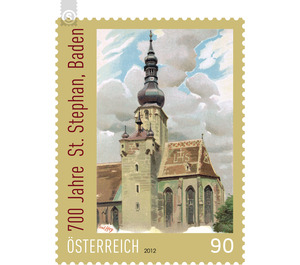700 years - Austria / II. Republic of Austria 2012 - 90 Euro Cent
Theme: Architecture
| Country | Austria / II. Republic of Austria |
| Issue Date | 2012 |
| Face Value | 90.00 |
| Edition Issued | 250,000 |
| Printing Type | offset |
| Stamp Type | Commemorative |
| Item Type | Stamp |
| Chronological Issue Number | 2354 |
| Chronological Chapter | OOS-OE2 |
| SID | 137142 |
| In 58 Wishlists | |
Continuation of the popular series "Churches in Austria": This special issue addresses the 700th anniversary of the founding of the main church of Baden, an elegant Biedermeier town south of Vienna. The motif of the stamp shows an aesthetic painting of the old rectory, created by a German painter and draftsman named Paul Hey (1867-1952). The history of the parish of St. Stephen: The first written mention of a priest in Baden goes back to the year 1220, which position this had - he may have been chaplain at the castle Baden - is not noted therein. When the nearby Traiskirchen was once placed with all its parish branches the monastery Melk, it came, now exactly 700 years, 1312, to the detachment of Baden. As an independent parish, initially under the patronage of Melk, 1729 was the former belonging to Passau territory ceded to the Archdiocese of Vienna; In 1784 Baden finally became a princely parish. The long and eventful past of the church is also reflected in the many different style elements of the building. From the Romanesque, for example, there are still animal heads, which are walled in under the vaults of the nave, remember the Gothic especially the baptismal font and several angel figures on the church walls and the south gate. From the time of the Renaissance, however, still grave monuments are preserved, some of which are attached to the columns of the church. In the course of the 18th century, in turn, the erection of several side altars in the nave of the church, special mention deserves the so-called Sebastian altar, which was donated by the Baden guarantee in memory of the plague year 1713 - this is also attested by a votive tablet, the today hanging over the exit at the sacristy. Traces of the Baroque are particularly evident in the altarpiece, depicting the stoning of St. Stephen, and in the valuable sacristy cupboard from 1743. Towards the end of the 19th century, extensive registra- tion works were begun, among other things, the neo-Gothic paneling as well as the choir stalls built. The impressive organ, brought here in 1787, was originally built for the Dorotheerkirche in Vienna. During the renovation in 1987, those original keys, on which Mozart and probably already Beethoven played, were reused. Speaking of Mozart: With his famous "Ave verum", specially composed for the local church, the Salzburg music genius also made a worthy memorial in the spa town of Baden.


